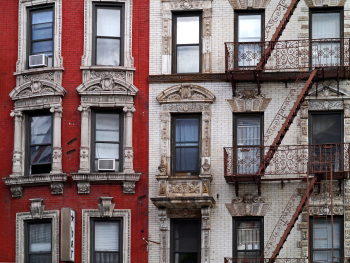

By Yiran He | Thu, March 27, 25
Energy efficiency and affordability are two big issues that are garnering support in New Hampshire, but more opportunities remain to advance both. Newly passed legislation shows how these two goals can go hand in hand. In February, Governor Kelly Ayotte signed Senate Bill 4, “An Act Relative to Commercial Property Assessed Clean Energy and Resiliency (C-PACER),” into law. This is an exciting milestone, as it marks the first bipartisan energy efficiency legislation passed in the state since 2022.
While the state has had a Property Assessed Clean Energy (PACE) program for commercial buildings since 2010, this updated version includes an implementation plan. This new law can unlock much-needed funding for housing development, particularly multifamily properties, while making buildings more energy-efficient and resilient. Building upgrades not only save money for residents but also improve the reliability of the state’s energy grid.
In this blog, we take a closer look at how energy efficiency in New Hampshire has slowed in recent years, how C-PACER can accelerate efficiency, what this means for affordable housing in the state, and what opportunities remain.
Energy Efficiency in New Hampshire Today
Since 2001, NHSaves has provided cost-effective energy efficiency solutions across the state. Run by utilities Eversource, Liberty Utilities, New Hampshire Electric Cooperative (NHEC), and Unitil, this program is funded by customers of electric and natural gas utilities. The goals are to reduce energy use, lower utility bills, and make New Hampshire more sustainable.
In recent years, energy efficiency efforts have slowed. In 2021, the state’s Public Utilities Commission paused some of its more ambitious energy initiatives, which would have set electricity savings goals at five percent and gas savings at three percent. The 2022-2023 plan that was approved instead set lower energy efficiency targets, at 1.6 percent of electric sales and 1.5 percent of gas sales. Under the 2024-2026 NHSaves plan, the state aims for 0.95 percent electric savings and 0.68 percent natural gas savings annually – less than other states in the region (for a comparison with other states in the NEEP region, check out our Regional Roundup).
The newly passed C-PACER implementation plan could help inject some fresh momentum into New Hampshire’s energy efficiency efforts and help the state reach its goals more effectively.
How C-PACER Can Boost Energy Efficiency
C-PACER, or Commercial Property Assessed Clean Energy and Resiliency, is a funding program that helps developers pay for energy efficiency projects. "C-PACER" is New Hampshire’s version of a PACE program for the commercial sector; the extra “R” stands for “resiliency,” adding a focus on making buildings both energy-efficient and resistant to severe weather.
Instead of paying for energy-efficient upgrades up front, developers can secure a loan that is paid back along with the property’s taxes. This system allows builders to upgrade buildings without the potential barrier of high upfront costs. By using the property itself as collateral, C-PACER loans also reduce the risk for lenders, which means they can offer lower interest rates to developers. This makes energy efficiency more affordable and helps spread the cost of improvements over a longer period.
PACE programs are already operating in 32 states and the District of Columbia, and they’ve helped fund thousands of projects. Nationally, C-PACE investments have supported 3,581 commercial projects to date and provided more than $9 billion of low-cost financing for clean energy and energy efficiency measures in commercial real estate. As of 2019, ACEEE reports cumulative savings of 6.3 billion kWh resulting from C-PACE funding across the country.
C-PACER was first introduced in New Hampshire in 2010 through House Bill 1554, but it didn’t get much traction. That version of the program required each city or town to manage the program separately, including developing its own list of qualified contractors and engineers, creating its own application process for developers, and handling delinquent borrowers. Overall, it was administratively cumbersome for many municipalities to implement.
The 2025 C-PACER bill changes that. It centralizes administration under the state’s Business Finance Authority (BFA), which streamlines the process and makes it much simpler. Now, cities and towns can opt into the program and designate specific areas as “energy efficiency and clean energy districts.” Developers who want to build in those districts can then apply directly to the BFA for funding, making the process run smoother and faster.
The revamped bill had bipartisan support, passing unanimously in the House, showing that energy efficiency can have universal appeal. This is the first bipartisan legislation passed regarding energy efficiency in New Hampshire since 2022’s HB549, which ensured the continuation of energy efficiency in the state. The new C-PACER legislation could open the door for more collaboration in the future.
How C-PACER Can Boost Affordable Housing in New Hampshire
A Win for Developers…
One of the biggest ways C-PACER can impact New Hampshire is by helping fund affordable housing projects. The need for affordable housing in the state is critical, and developers should be incentivized to build more. C-PACER can help by covering the costs of energy efficiency upgrades, which in turn frees up money that can go toward other parts of the building process. By reducing construction costs, C-PACER helps developers take out smaller loans, which can be a game-changer when it comes to building affordable housing. This makes it possible for developers to build more units.
C-PACE programs have a proven track record in the multifamily housing sector. Developers in other states have already used C-PACER funds to help raise capital to construct new apartment buildings and retrofit older existing ones. These loans can cover as much as 40 percent of the costs of building new units, which makes it possible to create more affordable housing.
…And a Win for Residents
Energy-efficient homes are a big win for residents, especially those in low-income households. Renters typically spend more on utilities as a percentage of income than homeowners, and that can take up a significant portion of their monthly expenses. Energy efficiency improvements can reduce energy use by up to 17 percent, and can reduce utility bills by as much as 30 percent, which improves affordability for renters who need it most.
There is huge untapped potential for savings in the multifamily sector, and C-PACER is a tool that can help unlock that potential.
Looking Forward for More Opportunities to Improve Affordability
In addition to fully implementing C-PACER, New Hampshire has other energy efficiency opportunities to advance energy affordability, including continued NHSaves program implementation, participation in the New England Heat Pump Accelerator, as well as potential adoption of the 2024 International Energy Conservation Code (IECC), which is currently under review by the state's Building Code Review Board. If the 2024 IECC is adopted, C-PACER financing could help developers afford the upfront costs associated with meeting these more advanced energy efficiency standards, reducing financial barriers and making it easier to build housing that is both highly efficient and affordable. Utility and state energy efficiency programs and building energy efficiency codes, together, will create local jobs, help residents by lowering bills, boost economic growth, and contribute to a more resilient energy grid.
Making housing more affordable and energy-efficient is a win-win. We're excited to see New Hampshire continue to advance its energy efficiency and cost-effectiveness priorities.



